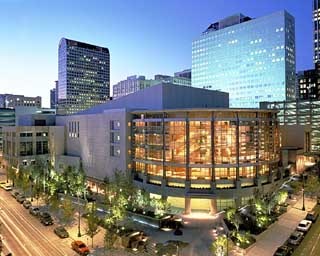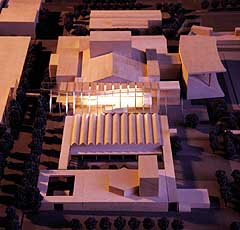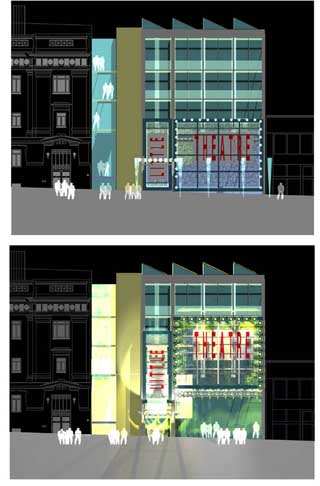
A&E Perspectives
Survey Index
Award Winners
DJC.COM
November 16, 2000
Extending boundaries in the performance arts
LMN Architects
In this era of strong support for performing arts facilities in Seattle, we have historic opportunities to break traditional boundaries and allow theaters to have a more dynamic impact on their settings and potential audience. Theaters can combine the best of traditional theater design, modern technology, and the art and technique of contemporary theater.

|
Where should the theatrical experience begin? Why shouldn’t it begin at the entrance to the theater or even theater district?
With performance art as a model, new possibilities open up. Architecture can mediate between experience and place. As theater moves out of the auditorium, design decisions are as much about the sensation, perception, and experience of place as about traditional architectural elements of window, wall, or column.
Ambiguity is the key. In order to create an overlap between the outside world and the actual performance onstage, ambiguity can be used as a strategy to achieve a compelling experience. It is possible at the same time to enrich our understanding of the way a building can interact with the site, regardless of the type. In exploring the relationship between daily life and the experiences of performance, we can intensify the relationship between the performance, the audience, and community at large. Some of our recent projects illustrate this interaction between life, theater, and architecture.
Taking it to the street
As home to the Pacific Northwest Ballet and the Seattle Opera, the renovated Marion Oliver McCaw Hall (formerly the Seattle Opera House) will become the focal point for the theater district at the Seattle Center. Opening in 2003, the 280,000-square-foot project includes new lobbies and enclosure, while improving the auditorium and rebuilding the stage house and performers’ wing. This project has been designed in collaboration with set designer Robert Israel, lighting artist Leni Schwendinger and landscape designer Kathryn Gustafson.

Courtesy LMN |
A major design objective is to create a way for the artistry on stage to be communicated to the broader community as well as the audience members. This is accomplished through the creation of a series of metal scrims that serve as both projection screens and spatial structure within public spaces. Overlapping the interior and exterior space, the scrims become screens for light projections that respond to current theatrical events in the building.
The scrims overlap just outside the entrance — creating ambiguity about the intersection between the artistry inside and its relationship to the larger community. The edge of the lobby enclosure weaves a serpentine wall through the scrim panels, creating a public courtyard. As a campus gateway, it serves both the performance patrons as well as pedestrians entering the Seattle Center, while diffusing the performance experience into the surrounding streetscape.
Putting theater into the design
The Little Theater on Capitol Hill will house a drama theater and other arts programs for Seattle Central Community College. The building will include a 200-seat theater and 26,000 square feet of studio space. A moveable screen at the entrance will convert the lobby into a theatrical studio by day. On performance nights, the screen will slide up to create a marquee and to open the lobby to the street. The screen to be mechanically-rigged in a way that is similar to a stage curtain or other theatrical element.

|
During the day, passersby can look through a screen layer at the street edge that changes and shutters the interior space. People will see hints of forms and movement as they peer inside. The frame can be raised to become a marquee, and a performance event announced as light spills out onto the street.
Creating performance arts venues in the city
Designing prominent public facilities within an urban setting involves integrating the life of the arts into the daily life of the city. Projects completed in the last few years have been designed to achieve these objectives.
Occupying an entire block at the very core of the city, Benaroya Hall celebrates the distinctive role of performance events while maintaining continuity between public and commercial life. At the center of the site are the rectangular form of the 2,500-seat concert hall and the circular lobby that embraces it. The transparent cylindrical volume of the lobby participates in the life of Seattle by giving the city a public room at an urban scale. The lobby glows like a well-lit stage — bringing to life the act of our citizens attending public performances and encouraging a sense of community. Inside, the lobby puts the city on a panoramic stage, affording views from its several levels, encompassing Puget Sound, the Seattle Art Museum, and the towers of the city’s skyline. At night, its surface of clear and frosted glass forms a giant lantern illuminating the streetscape.
Along the building’s south edge, a series of stairs and terraces steps down the street to a terraced memorial garden along Second Avenue and connects to an existing promenade link down to Puget Sound. Along Third Avenue, a block-long glazed arcade, with entrances from three streets, ties everything together, offering access to the concert hall and recital hall lobbies, the ticket office, shops, cafes, an underground garage, and the transit tunnel adjacent to the site.
As the centerpiece for the downtown core in Memphis, the Cook Convention Center Expansion and Renovation encompasses a new 2,000-seat performance theater that will be utilized primarily by the Memphis Symphony, Opera and Ballet. Flanked by the Mississippi River to the west and the downtown core to the east, the building mediates both the natural and urban site influences. The taut brick wall along Main Street and the monumental porch-like theater façade respond to both the historic and modern buildings of downtown, while more incremental massing, lobby overlooks, and landscaped terraces are compatible with the character of the riverside. The geometry of the auditorium is expressed as a distinctive shape, establishing the building’s presence as an important civic amenity, while integrated as a complementary piece of the Memphis skyline.
We are continuously challenged and inspired by the issues involved in designing for the arts. Working with performance arts groups reinforces our belief in the value of collaboration in design, since collaboration is at the heart of what they do. We learn from each architectural assignment and from our clients. Currently, LMN is designing performing arts projects in Washington, Nevada, Colorado, and Tennessee, and we are finalists in a national design competition. As we evolve in this building type, we anticipate the continual discovery of new ways to enrich our architectural insights and to benefit all of our projects.
Mark Reddington is a partner with LMN, and Sherrill Myers and Erik Indvik are principals in the firm. They specialize in the design of performing arts facilities.
Other Stories:
- NW architects prosper…and the community benefits
- The sun never sets on the extranet
- The new airport has arrived
- Making chaos work for you: keys to small firm management
- Little Yelm sets big environmental goals — and meets them
- Making space for the spirit in a medical facility
- Putting power back into public process
- Engineers build new sites on the Web
- Perfecting Pier 56
- Speed
- Thriving engineering field competes for tech talent
- Tacoma leads in light rail construction, station design
- Architecture for the knowledge economy
- Technology space, from core to shell
- The delight of a slow opera
Copyright ©2009 Seattle Daily Journal and DJC.COM.
Comments? Questions? Contact us.